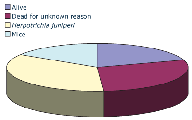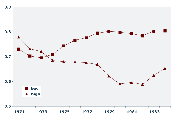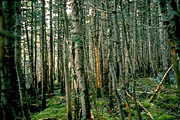 |
|
|
|
|
|
|
Growth of individual trees is determined by many factors of their biotic and abiotic environment. In the absence of environmental disturbance such as wind throw, avalanches or insect-outbreaks, individual growth, size, and survival largely depend on the availability of light, water and nutrients, which is determined by local resource abundance and the presence of competitors. Dense stands of trees may go through four phases: Establishment, thinning, transition and finally steady state.
Establishment The small size of plants during establishment makes them
susceptible to influences that do not affect larger individuals. Extreme
near ground microenvironment variations such as geomorphologic changes,
extreme moisture fluctuations, frost or heat may injure or kill a seedling.
Small size also makes the seedlings succeptible to predators and pathogens
and competition by forbs and grasses. |
|
Competition for resources As small trees reoccupy the available growing space they slowly begin to compete among each other for the resources light, water and nutrients. The available space for individual tree development directly effects the growth processes and may lead to plastic responses in allocation and morphology of individuals. Trees lose their lower, deeply-shaded foliage and branches. Understory trees slow in height growth and become flat topped. Shade tolerant species may grow very slowly and survive for many years in the understory. However, the opposite reaction, an increased height growth is observed in trees of slightly taller size. Height growth has high priority under competition for light because it places photosynthetically active tissue in the most advantageous position. |
|
Under competition slower growing and less vigorous individuals eventually die, because they are no longer able to compete with the dominant trees in either height or root growth. This suppression and death is a natural result of stand development. Most post-establishment tree mortality takes place during the phase of most intense competition and highest density of trees.
Transition and steady state Neighbouring trees quickly reoccupy any available growing
space and continue to compete for more space. After a long period where
only subordinate trees die, death of larger trees increases, triggered
by external influences. Abiotic processes such as strong winds or biotic
agents such as parasitic fungi have been observed to increase in frequency
in mature stands. As overstory trees grow larger, they occupy new growing
space less vigorously. When a minimum light level is achieved, species
with low light requirements may begin to germinate at the forest floor.
Shade tolerant species usually predominate in the forest floor substratum
and can differ from an overstory of shade intolerant species. |
|
Harper J L, Population
biology of plants, 1977, Academic Press, London. |
29 August 2011 |
||
| |
||




